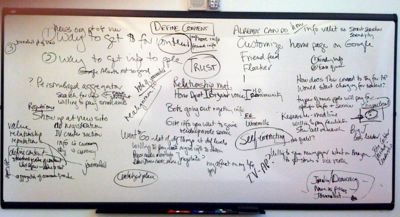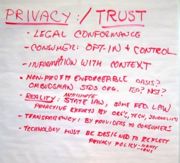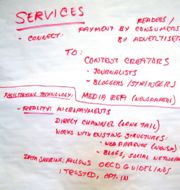Blueprint-bullets
From IVP Wiki
Contents
- 1 Here are bullet points recorded by breakout groups on Thursday, Dec. 4, 2008, at the IVP-Blueprint summit.
- 2 Report from the business models/legal/corp/marketing breakout group
- 3 Report back from the content / syndication breakout group
- 4 Report back from the advertising/demographics/privacy/ID breakout group
- 5 Privacy/trust
- 6 Services
Here are bullet points recorded by breakout groups on Thursday, Dec. 4, 2008, at the IVP-Blueprint summit.
Report from the business models/legal/corp/marketing breakout group
Content creators
- Focused reach
- Reach tiny niches economically
- Reach the long tail
- Make money on other peoples information (share value)
- A business that works
- Ability to influence development
Content consumers
- Convenience, security, privacy, monetizing relationships
- Content they like
- Content not available elsewhere
- Saving time and money
- Frictionless
- Ability to influence how this develops
- Scale ability to be compensated as creator as well as consumer
Commerce players
- Access to trusted nodes (papers, local brands, retailers)
- Monetize content through better value
- Access to content to more effectively market
- Unique channels to consumers
- Increases advertising efficiency
Aggregators of content
- Cuts down on acquisition cost of customers
- Antidote to Google
- Scale for important pieces of their business (e.g. OpenID)
- New customers for platforms
- Differential pricing
Educators
- Access to different genres of communication
- Access to new business models
- Narrowcasting, instead of broadcast mode
Regulators (beneficiary not stakeholder?)
- Self-policing organization (one instead of millions)
- Capabilities for better regulation than government
- Ability to generate new ideas and better ways of doing things
Report back from the content / syndication breakout group
Key issues raised
- Figure out a definition of content
- Movement of news as process rather than product
- How do you have transactions around it?
- Defining the role of journalists and journalism
Defining the InfoValet (Howard's definition)
A centralized place in which news providers could exchange with each other and with users things about value, relationships, reputation, information and even money.
Examples:
- A common registration platform – instead of many registration sites, one place where they register which gives them access to many different sites and registration information as value to all the sites that participate.
- A PayPal like setup where if they pay for low-rate content they don’t have to enter their credit card over and over again. Simplicity.
- Common place to sign up for text message or emails.
- Common set of ethical standards.
- Information exchange on the backend among participants
Report back from the advertising/demographics/privacy/ID breakout group
Privacy/trust
- Legal conformance (may requires laws that don’t exist)
- Bottom-up approach – consumer has opt in and control over the information they reveal – how it is used. With context.
- How? Some type of non-profit entity, maybe a standards organization, an enforceable ombudsman that speaks for the consumer. ISO? NST?
- Reality – state law will move faster than federal law. Federal will emerge from it.
- Should be proactive efforts now by organizations and technologists and journalists to socialize what is being said so laws don’t get created that cause more harm than good.
- Transparency as much as possible with consumers. Trust fundamental to making system work.
- Technology has to reflect all these principles of privacy policy.
Services
- -- Connect payment by advertisers to the content consumers and to the media rep/the newspaper channel collecting the information.
- -- Tech realities to include:
- -- Micropayments
- -- Direct channels to groups
- -- Needs to work with existing systems (blogs, social networks)
- -- Has to be trusted, opt-in system


